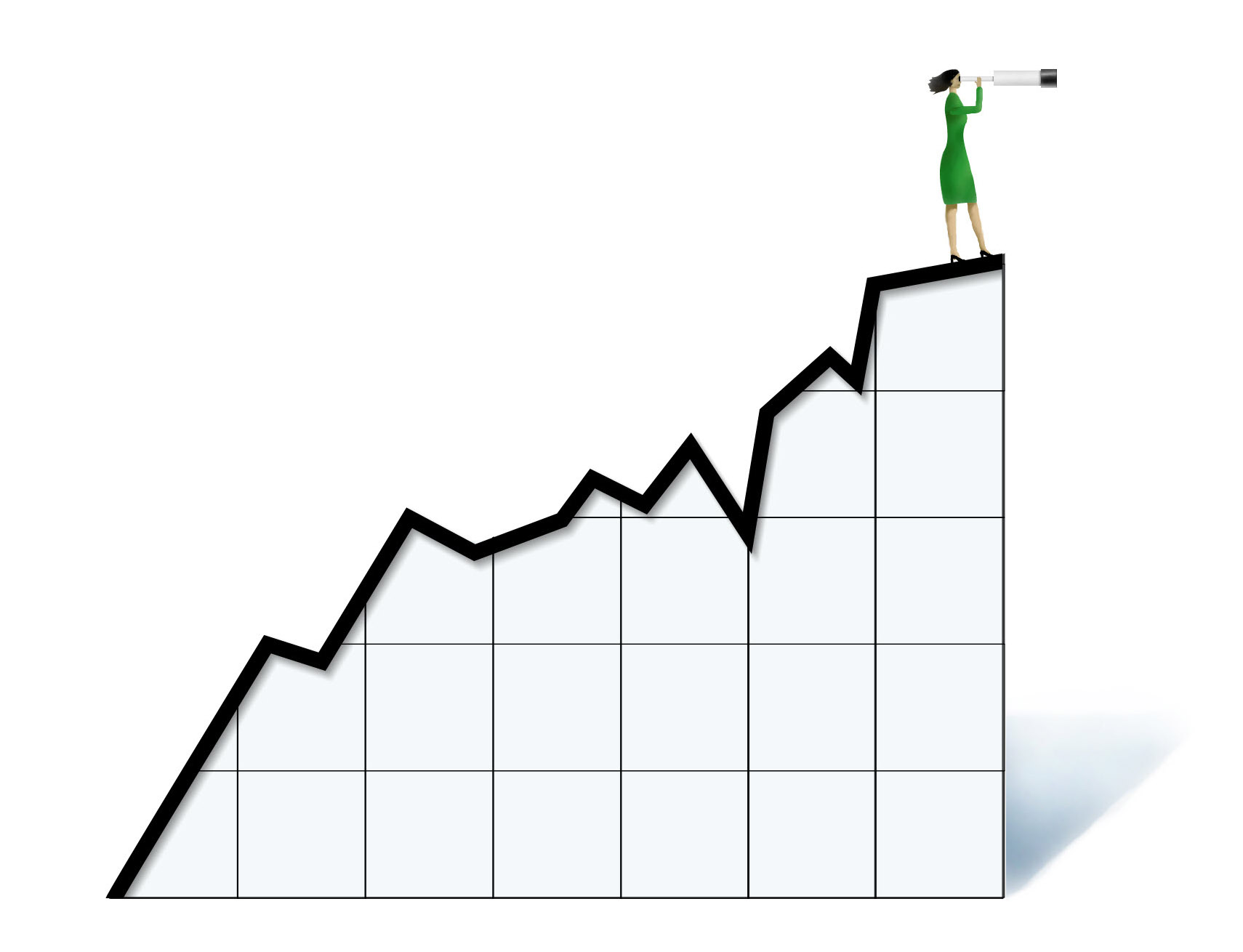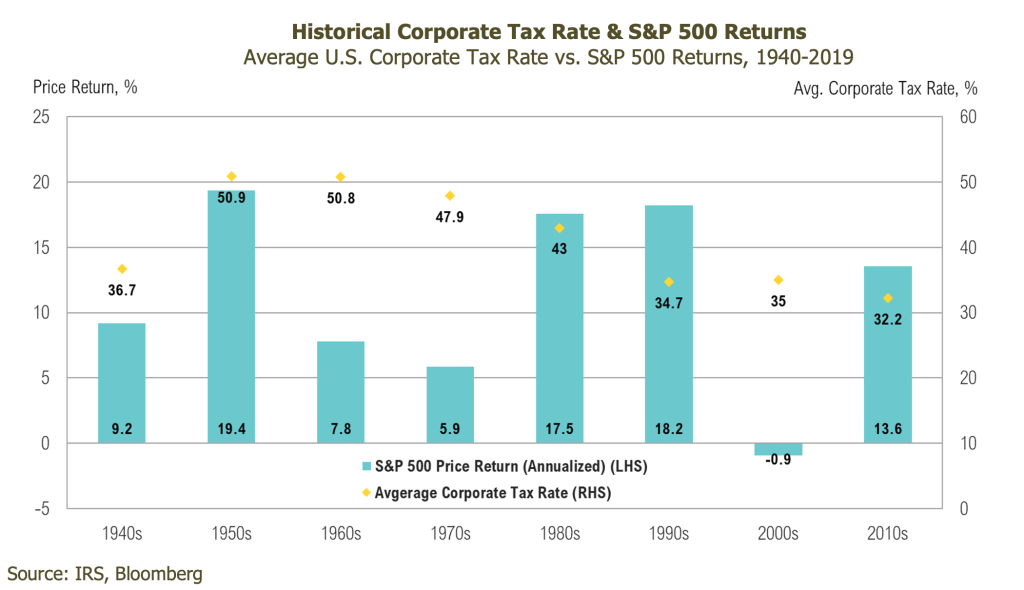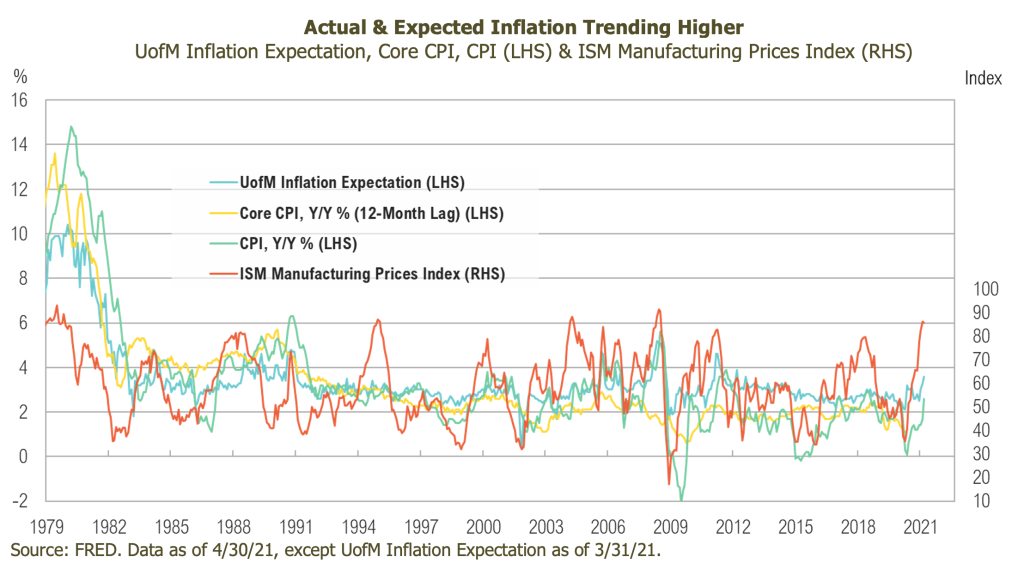Markets
Risky assets grinded higher in April as they digested one of the best 12-month periods in history. At the end of the month, most asset classes were sporting year-to-date returns that would be considered attractive for an entire year. The broad-based nature of April’s returns, extending even to bonds, seems due to policymakers’ continued, extraordinary monetary and fiscal support.
Growth companies outperformed value companies during the month as the decline in interest rates helped their relative performance. After rising to 1.75% by the end of the first quarter, the 10-Year U.S. Treasury Yield finished April at 1.63%. The fact that the parabolic rise in yields took a break—and even declined slightly—helped push growth stocks higher. That’s because the discount rate is used in valuation calculations, and when it drops, it increases the present value of longer-duration growth assets. If interest rates continue to increase, it may once again favor value stock.
Policy
On the eve of his hundredth day in office—April 28, 2021—President Biden announced several potentially material policy initiatives as part of the American Families Plan, including raising the federal minimum wage to $15 per hour, adding an additional $1.8 trillion stimulus program, and increasing the capital gains tax rate to 39.6% for individuals earning over $1 million.1 If passed into law, the top capital gains tax rate would then be at its highest since the 1920s.2
Broadly speaking, markets have so far shrugged off this news, likely for a few reasons. First, Biden’s initial numbers might indicate more of a starting point from which he can negotiate. Second, according to a recent Tax Policy Center report, only approximately 25% of the U.S. stock market is owned by U.S. investors outside of tax-deferred accounts.3 As such, the impact of a higher U.S. capital gains tax rate may be limited. Finally, historical data suggest that both corporate tax and private capital gains tax rates have had a muted impact on either market performance or economic growth.4
Biden’s tax plan also proposed several changes to corporate tax rates, the most significant being an increase in the corporate tax rate from 21% to 28%. Here, too, historical data show little relationship between the corporate tax rate and stock market returns. 5,9
Inflation
As we move past the one-year anniversary of the initial COVID-19 shut-downs, inflation numbers—which are traditionally reported on a year-over-year basis—are starting to reflect the jarring juxtaposition between the economic environment today versus last spring.
According to the U.S. Bureau of Labor Statistics, the Consumer Price Index rose 4.2% for the year ending April 2021. This represented its largest year-over-year increase since September 2008. The increase was driven largely by food prices, which increased 2.4%, and energy prices, which rose 25.1%. While these numbers seem headline-worthy, they are partly the result of the anniversary effect of depressed prices from last year. That said, the anniversary effect cannot entirely explain the increased prices of many commodities that are critical to a wide range of economic activities.
Few comparisons are as extreme—and evident to the average American—as the rise in lumber prices. Lumber, the generic term used to refer to a random length lumber futures contract (110 board feet in 2-inch by 4-inch pieces of varying lengths),6 has been squeezed by both increases in demand as well as severe supply disruptions. On the demand front, there’s the perfect storm of the mass migration out of cities into single family homes in lower-density areas, combined with low interest rates and unusually strong personal incomes. On the supply side, lumber mills have been running at reduced capacity due to the pandemic, and they are struggling to keep up.7 Adding insult to injury, a pine-eating beetle has infested British Columbia, Canada, and shaved 5-7% off the total U.S. lumber supply.8 The extreme dynamics in lumber are also impacting the housing market. Median home prices have increased by almost 20% in the U.S. while the inventory of homes for sale has hit an all-time low.9
Lumber is a quirky example, but it helps illustrate the downside of higher inflation and the corner policymakers have painted themselves into. If they continue to keep rates low, print enough electronic money via quantitative easing, purchase financial assets by the trillions, backstop bond markets, and even send stimulus checks directly to consumers, they will be able to manufacture growth and elevate the prices of various assets, both financial and real. However, money is fungible; you cannot control where it ends up. At some point, consumers—and markets—may view higher prices, especially in commodity prices, more dubiously.
Looking Forward
Over the past year, the U.S. economy and capital markets have benefited from exploding money supply growth, historically low interest rates, unprecedented monetary policy support, and massive fiscal stimulus, including direct stimulus checks to consumers. For perspective, current transfer payments from the federal government now account for 21% of all U.S. personal income.10 This tidal wave of stimulus has been incredibly positive for markets; however, as the money begins to flow into the real economy, the prices of goods and services are starting to increase—in some cases substantially. We continue to believe that navigating this unusual policy-driven world will require reading the inflation tea leaves and monitoring if and when higher prices become less desirable than some economic textbooks suggest.
The rally in risk assets is likely to persist amid promises of fiscal stimulus from the White House and the continued distribution of vaccines. However, we believe most fixed income securities—in particular, higher-quality bonds—will produce returns significantly below their historical average. Some fixed income investments may produce negative returns over short time periods. With all of this in mind, we will strive to balance opportunities in the current environment while remaining cognizant of the increasing risks. RMB believes this is a good time for investors to evaluate exposures in portfolios. As always, we recommend maintaining diversified portfolios of investments that anticipate a broad range of outcomes. During this time, we recommend overweighting non-U.S. equities within global equity portfolios, and we favor small companies over large-capitalization companies. Given the ongoing rally in markets around the world, we continue to focus on dislocations in various niche markets that present attractive risk/reward opportunities.
1White House: https://www.whitehouse.gov/briefing-room/statements-releases/2021/04/28/fact-sheet-the-american-families-plan/
2Reuters: https://www.reuters.com/business/biden-propose-hike-capital-gains-taxes-pay-more-child-care-sources-2021-04-22/
3Tax Policy Center: https://www.taxpolicycenter.org/taxvox/who-owns-us-stock-foreigners-and-rich-americans
4UBS: https://www.ubs.com/global/en/wealth-management/our-approach/marketnews/article.1527032.html?caasID=CAAS-FASocial
5IRS: https://www.irs.gov/statistics/soi-tax-stats-historical-table-24
6CME: https://www.cmegroup.com/trading/agricultural/files/AC-243_RanLenLumberBrochure.pdf
7Vox: https://www.vox.com/22410713/lumber-prices-shortage
8Quartz: https://qz.com/1985276/america-is-running-short-of-wood/
9Bloomberg
10WSJ: https://www.wsj.com/articles/consumer-spending-personal-income-march-2021-11619732790
All market pricing and performance data from Bloomberg, unless otherwise cited. Asset class and sector performance are gross of fees unless otherwise indicated.
The opinions and analyses expressed in this newsletter are based on RMB Capital Management, LLC’s (“RMB Capital”) research and professional experience, and are expressed as of the date of our mailing of this newsletter. Certain information expressed represents an assessment at a specific point in time and is not intended to be a forecast or guarantee of future results, nor is it intended to speak to any future time periods. RMB Capital makes no warranty or representation, express or implied, nor does RMB Capital accept any liability, with respect to the information and data set forth herein, and RMB Capital specifically disclaims any duty to update any of the information and data contained in this newsletter. The information and data in this newsletter does not constitute legal, tax, accounting, investment or other professional advice. Returns are presented net of fees. An investment cannot be made directly in an index. The index data assumes reinvestment of all income and does not bear fees, taxes, or transaction costs. The investment strategy and types of securities held by the comparison index may be substantially different from the investment strategy and types of securities held by your account. The S&P 500 Index is widely regarded as the best single gauge of the U.S equity market. It includes 500 leading companies in leading industries of the U.S economy. The S&P 500 focuses on the large cap segment of the market and covers 75% of U.S. equities. University of Michigan (UoM) Inflation Expectations measures the percentage that consumers expect the price of goods and services to change during the next 12 months. ISM Manufacturing Prices Paid is one of the diffuse indicators, based on which the Supply Management Institute calculates the Manufacturing PMI. It reflects a change in prices paid by industry representatives for the products or services they receive. The Core CPI: Core inflation is the change in the costs of goods and services but does not include those from the food and energy sectors. The Consumer Price Index (CPI) is a measure of the average change over time in the prices paid by urban consumers for a market basket of consumer goods and services. Goods and services are broken into 8 major categories: food and beverage, housing, apparel, transportation, medical care, recreation, education and communication, and other goods and services.










